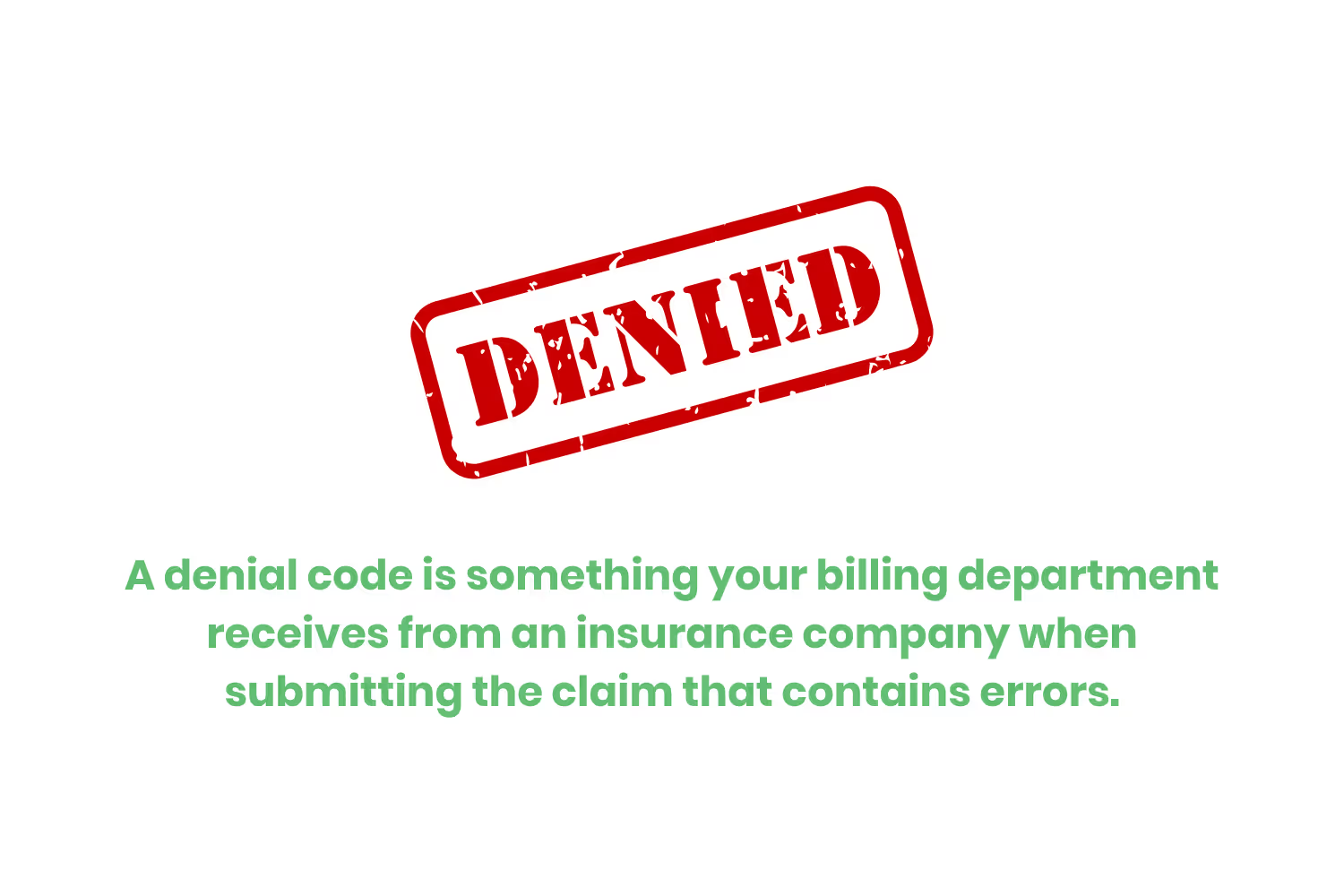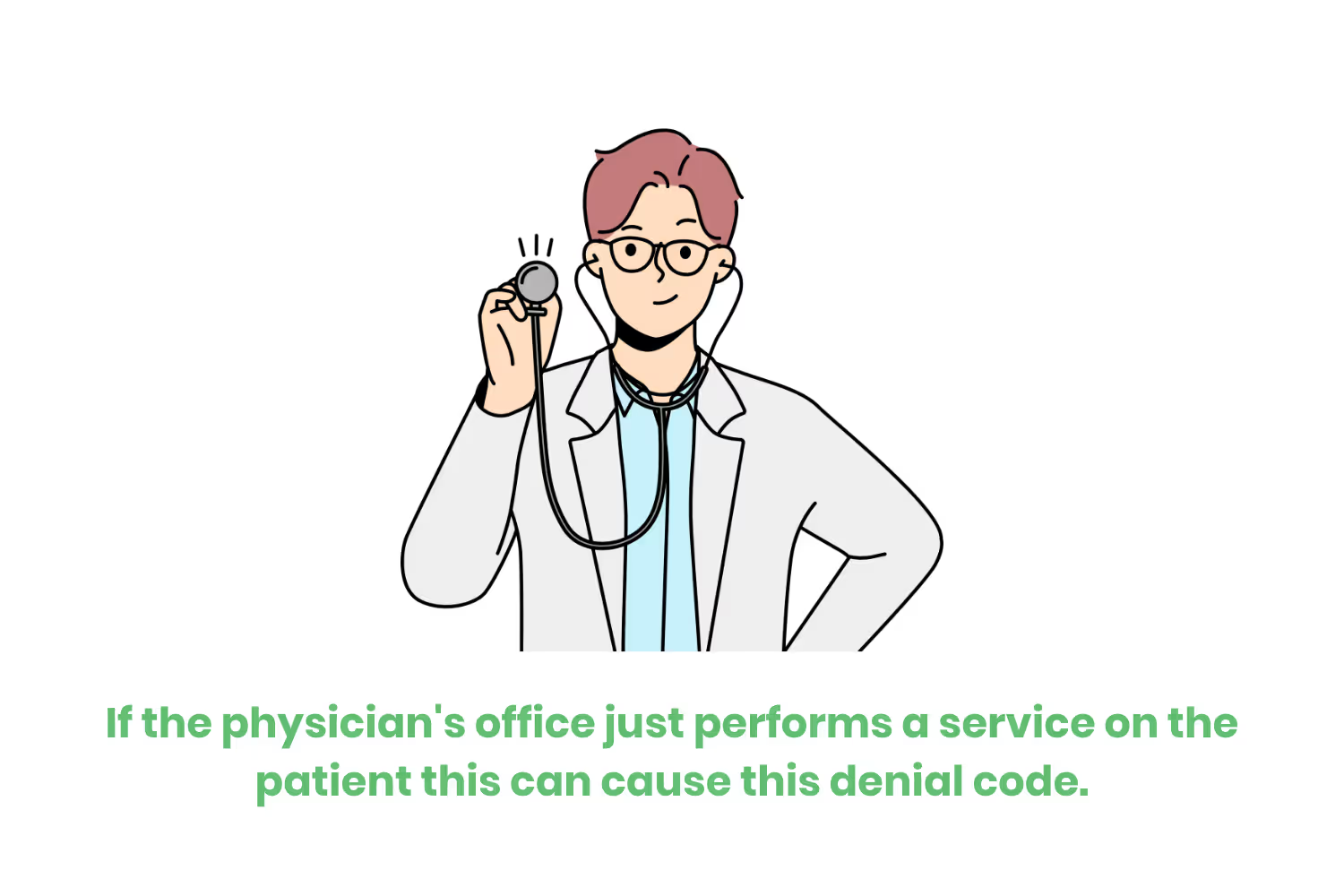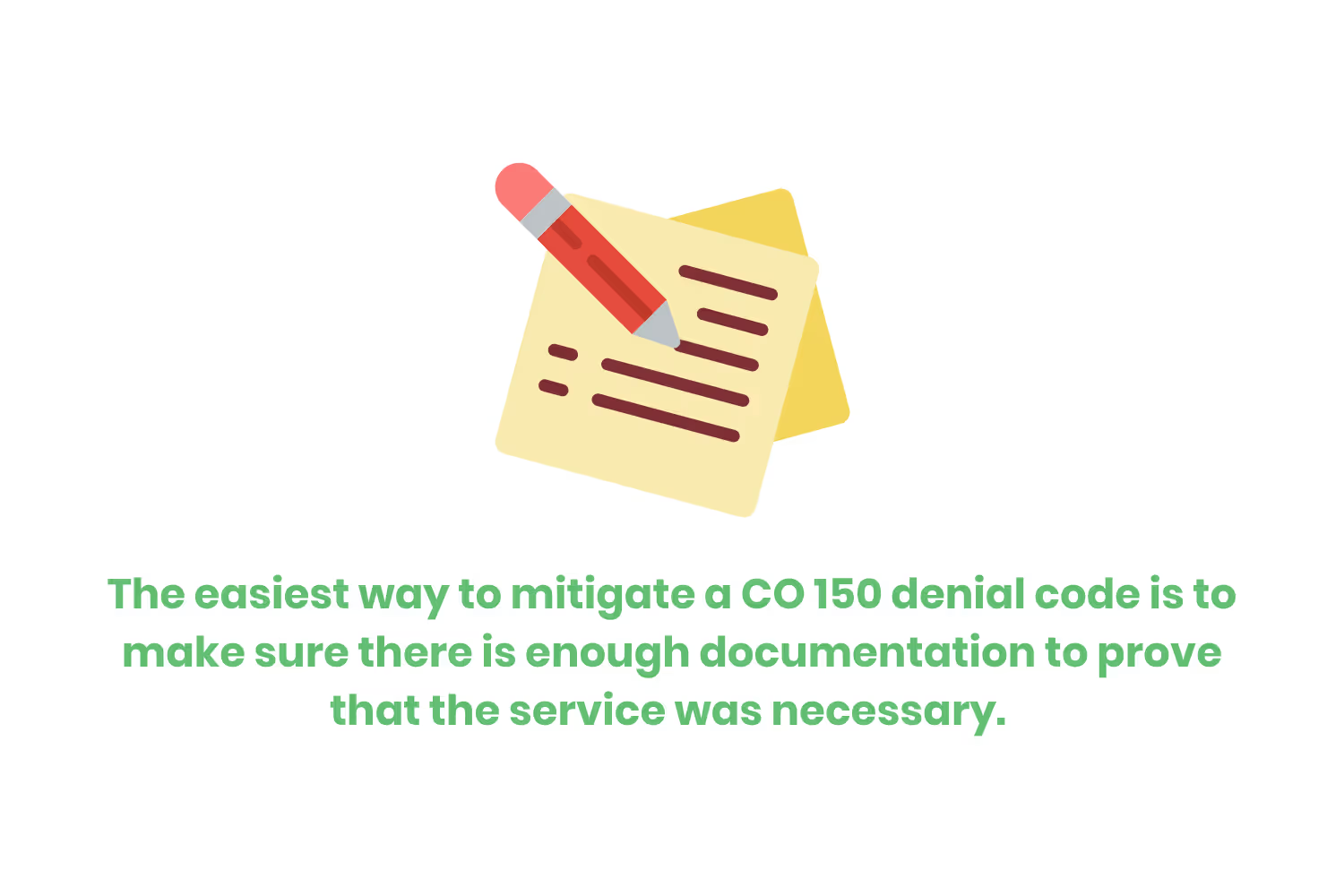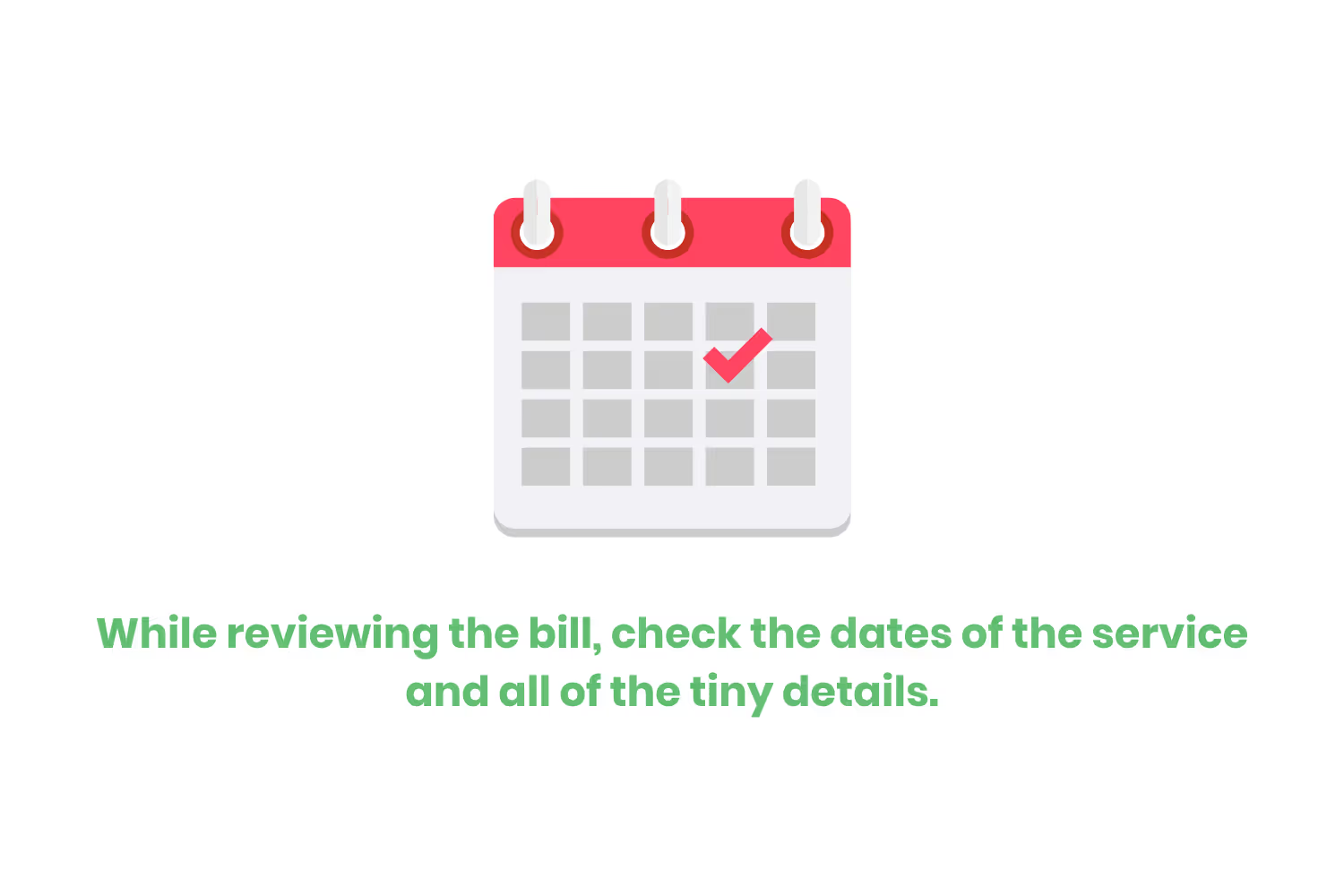Denial Code CO 150: An Ultimate Guide
In today’s blog we specifically discuss denial code CO 150 to include what causes it and most importantly how you can mitigate it.

Did you know that 1 in every 7 claims submitted get denied, which adds up to close to 200 million claims that get denied each year. That’s a MASSIVE number of claims that get redirected to billing departments…which leads to a backed revenue cycle and delays in healthcare organizations getting paid.
Now you may be wondering how you can stop receiving denial codes?
I hate to be the one to tell you but….. there's no way to get rid of ALL the denial codes. I know I know, this is upsetting but a truth you need to accept early on.

Rather than focusing on getting rid of the inevitable entirely, there’s a way to help reduce and or mitigate the occurrence of denials coming back to your organization. As a clearinghouse provider for over 25 years, we’ve helped our clients mitigate every denial code that exists. Due to our experience, we’ve been able to discover the causes and their underlying patterns so that you can mitigate them and enhance your revenue.
In today’s blog we specifically discuss denial code CO 150 to include what causes it and most importantly how you can mitigate it.
What is a Denial Code?
Now I'm sure this all can sound overwhelming, especially after the doom and gloom in the introduction of this post. But, I promise it’s not too complicated.
Let's first break down what exactly a denial code is to establish some common ground.
A denial code is something your billing department receives from an insurance company when submitting the claim that contains errors. If you receive a denial code it's not something to celebrate.

Luckily, the specific denial code attached to a claim specifies exactly what’s incorrect with the claim. However, there are hundreds of denial codes, and they all give rather vague reason descriptions
There are two main categories of denial codes, the first kind is a CO Denial Code, the CO stands for Contractually Obligated. This means the insurance provider has to pay the bill, by the contract they have with the patient.
The other type of denial code is a PR denial code, the PR stands for Patient Responsibility. This means that the patient is responsible for the entirety of the bill.
What is Denial Code CO 150?
Now that we’ve established a baseline and you know exactly what a denial code is , let's break down what denial code CO 150 is.
Unfortunately for your billing department a CO 150 denial isn’t the easiest denial code to resolve. You see, CO 150 can mean multiple different things…which is exactly why it’s so difficult for organizations to resolve.
CO 150 happens when the information billed doesn’t line up with the doctor’s notes.
To simplify it, they believe that the service performed was not necessary with the information they have.

What Causes Denial Code CO 150?
Okay now that you understand what denial code CO 150, I'm sure you're asking yourself what causes it.
Inadequate Documentation
After the doctor provides the service, their next step is to document everything that happens in the appointment.
Yes, everything…this can help the billing department figure out what exactly happened and how they should proceed with coding the bill.
If there’s not proper documentation it leads to a claim submission with little to no information on what happened at the time of service. This will cause denials due to the lack of documentation.
Lack of Necessity
The other thing that can cause a denial code is the lack of necessity of the service. This cause is pretty straightforward, but goes hand and hand with the first cause.
If the billing department receives a code, and checks the patients records, and sees there was no reason for the service…the insurance company will deny the claim and you will get this denial code.
Non-Covered Services
There are some situations where the service is not covered by the insurance completely.
This will be due to the patient's insurance coverage.
It also can happen when the previous services provided to the patient. If the physician has tried nothing else besides the most extreme service. The insurance company will not cover it.
Lack of Prior Authorization
If the physician's office just performs a service on the patient this can cause this denial code.
This can be due to the service needing to get approved before the service. Without receiving this authorization, it can lead to this specific denial code.

Incorrect Code
When the billing department is submitting claims they connect all the services to CPT codes or Current Procedural Terminology.
These codes make it easier for the insurance company to dissect what happened in the appointment.
If these CPT codes are incorrect it can cause the insurance company to think other services occurred in the appointment. This can cause them to deny it, especially if the code is very wrong.
Ensuring you understand the causes of this denial code, is the first step in trying to reduce the amount of denial codes you receive.
How to Mitigate Denial Code CO 150
Now that you know more about what denial code CO 150 is, let's talk about the ways to mitigate this denial code.
Proper Documentation
The easiest way to mitigate this denial code is to make sure there is enough documentation to prove that the service was necessary.
Having this documentation will help the insurance company understand what happened in the appointment, and what the physician and patient have already tried.
This can help reduce some of the reasons for the denial code.

Acquiring Authorization Before The Service
This simple step can help reduce the amount of denial codes you receive. This is because you are getting that authorization before the service.
Giving the billing department time to deny the service before it is even performed.
Proper Staff Training
Now this may seem obvious but this is the most overlooked step.
Denial codes change…some in place today might get deleted all together in future. If your staff isn’t keeping up with the changes can cause many denial codes.
Hire a Clearinghouse
Hiring a clearinghouse to help scrub the claims can be the best way to reduce any denial code.
The billing department will send the claims to the clearinghouse BEFORE sending it to the insurance company
This allows the clearinghouse to scrub the claim looking for any and all errors. If it does find any errors they will send it back to the billing department with what was wrong with the claim.
If you focus on implementing these strategies, it can help you reduce the occurrence of denial code CO 150.
Addressing Denial Code CO 150
Unfortunately, you can implement all of the strategies above, but still see denial code CO 150.
I know, I know it's frustrating to say the least. Nevertheless, it’s important for your billing department to understand how to properly address the denial code if they see it.
Check Physician Documentation
This is the first thing you should do if you believe you got this denial code out of error.
You can check the physician notes to ensure that the service was necessary. If the service was necessary you can file an appeal which we will discuss later.
Check Patients Insurance Policy
The billing department can receive this denial code out of error as the insurance company is human and could have made a mistake.
This is why your billing department should dive into the patient's insurance policy to see if this denial code was reasonable.
Review the Bill for Coding Errors

Now this should happen before the insurance company, but if it wasn't now is the time. If the bill is incorrect it can lead to this denial code.
While reviewing the bill, check the dates of the service and all of the tiny details.
This can be the reason for the denial code.
Resubmit the Claim or Appeal the Claim
If the Bill is Correct: The next step is to appeal the claim if the Bill has no errors. You will need to submit all documentation, such as proof of coverage, to help support the appeal. It is vital that you have all of the vital information to back up your appeal when submitting it.
If the Bill Contains Errors: You should fix the claim, double check there are no errors. Then resubmit it to the Insurance Company.
Conclusion
Denial codes can feel like an uphill battle, but they don’t have to define your revenue cycle.
By understanding the causes of denial code CO 150 and implementing proactive strategies like proper documentation, prior authorization, and staff training, you can significantly reduce these challenges.
Even when this code pops up, addressing it with a thorough review and quick action ensures that your claims have the best chance of approval.
Remember, it’s not about eliminating every denial—it’s about staying prepared and building a process that minimizes delays and secures payments faster.
Emphasize your product's unique features or benefits to differentiate it from competitors
In nec dictum adipiscing pharetra enim etiam scelerisque dolor purus ipsum egestas cursus vulputate arcu egestas ut eu sed mollis consectetur mattis pharetra curabitur et maecenas in mattis fames consectetur ipsum quis risus mauris aliquam ornare nisl purus at ipsum nulla accumsan consectetur vestibulum suspendisse aliquam condimentum scelerisque lacinia pellentesque vestibulum condimentum turpis ligula pharetra dictum sapien facilisis sapien at sagittis et cursus congue.
- Pharetra curabitur et maecenas in mattis fames consectetur ipsum quis risus.
- Justo urna nisi auctor consequat consectetur dolor lectus blandit.
- Eget egestas volutpat lacinia vestibulum vitae mattis hendrerit.
- Ornare elit odio tellus orci bibendum dictum id sem congue enim amet diam.
Incorporate statistics or specific numbers to highlight the effectiveness or popularity of your offering
Convallis pellentesque ullamcorper sapien sed tristique fermentum proin amet quam tincidunt feugiat vitae neque quisque odio ut pellentesque ac mauris eget lectus. Pretium arcu turpis lacus sapien sit at eu sapien duis magna nunc nibh nam non ut nibh ultrices ultrices elementum egestas enim nisl sed cursus pellentesque sit dignissim enim euismod sit et convallis sed pelis viverra quam at nisl sit pharetra enim nisl nec vestibulum posuere in volutpat sed blandit neque risus.

Use time-sensitive language to encourage immediate action, such as "Limited Time Offer
Feugiat vitae neque quisque odio ut pellentesque ac mauris eget lectus. Pretium arcu turpis lacus sapien sit at eu sapien duis magna nunc nibh nam non ut nibh ultrices ultrices elementum egestas enim nisl sed cursus pellentesque sit dignissim enim euismod sit et convallis sed pelis viverra quam at nisl sit pharetra enim nisl nec vestibulum posuere in volutpat sed blandit neque risus.
- Pharetra curabitur et maecenas in mattis fames consectetur ipsum quis risus.
- Justo urna nisi auctor consequat consectetur dolor lectus blandit.
- Eget egestas volutpat lacinia vestibulum vitae mattis hendrerit.
- Ornare elit odio tellus orci bibendum dictum id sem congue enim amet diam.
Address customer pain points directly by showing how your product solves their problems
Feugiat vitae neque quisque odio ut pellentesque ac mauris eget lectus. Pretium arcu turpis lacus sapien sit at eu sapien duis magna nunc nibh nam non ut nibh ultrices ultrices elementum egestas enim nisl sed cursus pellentesque sit dignissim enim euismod sit et convallis sed pelis viverra quam at nisl sit pharetra enim nisl nec vestibulum posuere in volutpat sed blandit neque risus.
Vel etiam vel amet aenean eget in habitasse nunc duis tellus sem turpis risus aliquam ac volutpat tellus eu faucibus ullamcorper.
Tailor titles to your ideal customer segment using phrases like "Designed for Busy Professionals
Sed pretium id nibh id sit felis vitae volutpat volutpat adipiscing at sodales neque lectus mi phasellus commodo at elit suspendisse ornare faucibus lectus purus viverra in nec aliquet commodo et sed sed nisi tempor mi pellentesque arcu viverra pretium duis enim vulputate dignissim etiam ultrices vitae neque urna proin nibh diam turpis augue lacus.



![[ANSWERED] What is a Long-Term Care (LTC) Pharmacy](https://cdn.prod.website-files.com/67e2b8210878abcba6f91ae6/68d687806a075a1cf64659b0_WhatisLongTermCarePharmacy_925.avif)
